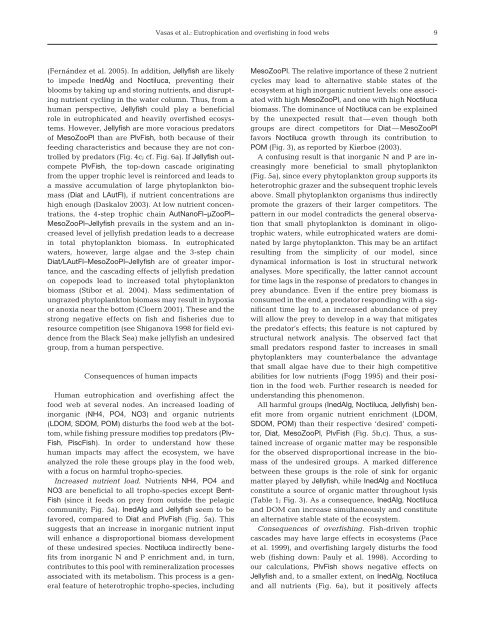Eutrophication and overfishing in temperate nearshore pelagic food
Eutrophication and overfishing in temperate nearshore pelagic food
Eutrophication and overfishing in temperate nearshore pelagic food
- No tags were found...
Create successful ePaper yourself
Turn your PDF publications into a flip-book with our unique Google optimized e-Paper software.
Vasas et al.: <strong>Eutrophication</strong> <strong>and</strong> <strong>overfish<strong>in</strong>g</strong> <strong>in</strong> <strong>food</strong> webs9(Fernández et al. 2005). In addition, Jellyfish are likelyto impede InedAlg <strong>and</strong> Noctiluca, prevent<strong>in</strong>g theirblooms by tak<strong>in</strong>g up <strong>and</strong> stor<strong>in</strong>g nutrients, <strong>and</strong> disrupt<strong>in</strong>gnutrient cycl<strong>in</strong>g <strong>in</strong> the water column. Thus, from ahuman perspective, Jellyfish could play a beneficialrole <strong>in</strong> eutrophicated <strong>and</strong> heavily overfished ecosystems.However, Jellyfish are more voracious predatorsof MesoZooPl than are PlvFish, both because of theirfeed<strong>in</strong>g characteristics <strong>and</strong> because they are not controlledby predators (Fig. 4c; cf. Fig. 6a). If Jellyfish outcompetePlvFish, the top-down cascade orig<strong>in</strong>at<strong>in</strong>gfrom the upper trophic level is re<strong>in</strong>forced <strong>and</strong> leads toa massive accumulation of large phytoplankton biomass(Diat <strong>and</strong> LAutFl), if nutrient concentrations arehigh enough (Daskalov 2003). At low nutrient concentrations,the 4-step trophic cha<strong>in</strong> AutNanoFl–µZooPl–MesoZooPl–Jellyfish prevails <strong>in</strong> the system <strong>and</strong> an <strong>in</strong>creasedlevel of jellyfish predation leads to a decrease<strong>in</strong> total phytoplankton biomass. In eutrophicatedwaters, however, large algae <strong>and</strong> the 3-step cha<strong>in</strong>Diat/LAutFl–MesoZooPl–Jellyfish are of greater importance,<strong>and</strong> the cascad<strong>in</strong>g effects of jellyfish predationon copepods lead to <strong>in</strong>creased total phytoplanktonbiomass (Stibor et al. 2004). Mass sedimentation ofungrazed phytoplankton biomass may result <strong>in</strong> hypoxiaor anoxia near the bottom (Cloern 2001). These <strong>and</strong> thestrong negative effects on fish <strong>and</strong> fisheries due toresource competition (see Shiganova 1998 for field evidencefrom the Black Sea) make jellyfish an undesiredgroup, from a human perspective.Consequences of human impactsHuman eutrophication <strong>and</strong> <strong>overfish<strong>in</strong>g</strong> affect the<strong>food</strong> web at several nodes. An <strong>in</strong>creased load<strong>in</strong>g of<strong>in</strong>organic (NH4, PO4, NO3) <strong>and</strong> organic nutrients(LDOM, SDOM, POM) disturbs the <strong>food</strong> web at the bottom,while fish<strong>in</strong>g pressure modifies top predators (Plv-Fish, PiscFish). In order to underst<strong>and</strong> how thesehuman impacts may affect the ecosystem, we haveanalyzed the role these groups play <strong>in</strong> the <strong>food</strong> web,with a focus on harmful tropho-species.Increased nutrient load. Nutrients NH4, PO4 <strong>and</strong>NO3 are beneficial to all tropho-species except Bent-Fish (s<strong>in</strong>ce it feeds on prey from outside the <strong>pelagic</strong>community; Fig. 5a). InedAlg <strong>and</strong> Jellyfish seem to befavored, compared to Diat <strong>and</strong> PlvFish (Fig. 5a). Thissuggests that an <strong>in</strong>crease <strong>in</strong> <strong>in</strong>organic nutrient <strong>in</strong>putwill enhance a disproportional biomass developmentof these undesired species. Noctiluca <strong>in</strong>directly benefitsfrom <strong>in</strong>organic N <strong>and</strong> P enrichment <strong>and</strong>, <strong>in</strong> turn,contributes to this pool with rem<strong>in</strong>eralization processesassociated with its metabolism. This process is a generalfeature of heterotrophic tropho-species, <strong>in</strong>clud<strong>in</strong>gMesoZooPl. The relative importance of these 2 nutrientcycles may lead to alternative stable states of theecosystem at high <strong>in</strong>organic nutrient levels: one associatedwith high MesoZooPl, <strong>and</strong> one with high Noctilucabiomass. The dom<strong>in</strong>ance of Noctiluca can be expla<strong>in</strong>edby the unexpected result that—even though bothgroups are direct competitors for Diat—MesoZooPlfavors Noctiluca growth through its contribution toPOM (Fig. 3), as reported by Kiørboe (2003).A confus<strong>in</strong>g result is that <strong>in</strong>organic N <strong>and</strong> P are <strong>in</strong>creas<strong>in</strong>glymore beneficial to small phytoplankton(Fig. 5a), s<strong>in</strong>ce every phytoplankton group supports itsheterotrophic grazer <strong>and</strong> the subsequent trophic levelsabove. Small phytoplankton organisms thus <strong>in</strong>directlypromote the grazers of their larger competitors. Thepattern <strong>in</strong> our model contradicts the general observationthat small phytoplankton is dom<strong>in</strong>ant <strong>in</strong> oligotrophicwaters, while eutrophicated waters are dom<strong>in</strong>atedby large phytoplankton. This may be an artifactresult<strong>in</strong>g from the simplicity of our model, s<strong>in</strong>cedynamical <strong>in</strong>formation is lost <strong>in</strong> structural networkanalyses. More specifically, the latter cannot accountfor time lags <strong>in</strong> the response of predators to changes <strong>in</strong>prey abundance. Even if the entire prey biomass isconsumed <strong>in</strong> the end, a predator respond<strong>in</strong>g with a significanttime lag to an <strong>in</strong>creased abundance of preywill allow the prey to develop <strong>in</strong> a way that mitigatesthe predator’s effects; this feature is not captured bystructural network analysis. The observed fact thatsmall predators respond faster to <strong>in</strong>creases <strong>in</strong> smallphytoplankters may counterbalance the advantagethat small algae have due to their high competitiveabilities for low nutrients (Fogg 1995) <strong>and</strong> their position<strong>in</strong> the <strong>food</strong> web. Further research is needed forunderst<strong>and</strong><strong>in</strong>g this phenomenon.All harmful groups (InedAlg, Noctiluca, Jellyfish) benefitmore from organic nutrient enrichment (LDOM,SDOM, POM) than their respective ‘desired’ competitor,Diat, MesoZooPl, PlvFish (Fig. 5b,c). Thus, a susta<strong>in</strong>ed<strong>in</strong>crease of organic matter may be responsiblefor the observed disproportional <strong>in</strong>crease <strong>in</strong> the biomassof the undesired groups. A marked differencebetween these groups is the role of s<strong>in</strong>k for organicmatter played by Jellyfish, while InedAlg <strong>and</strong> Noctilucaconstitute a source of organic matter throughout lysis(Table 1; Fig. 3). As a consequence, InedAlg, Noctiluca<strong>and</strong> DOM can <strong>in</strong>crease simultaneously <strong>and</strong> constitutean alternative stable state of the ecosystem.Consequences of <strong>overfish<strong>in</strong>g</strong>. Fish-driven trophiccascades may have large effects <strong>in</strong> ecosystems (Paceet al. 1999), <strong>and</strong> <strong>overfish<strong>in</strong>g</strong> largely disturbs the <strong>food</strong>web (fish<strong>in</strong>g down: Pauly et al. 1998). Accord<strong>in</strong>g toour calculations, PlvFish shows negative effects onJellyfish <strong>and</strong>, to a smaller extent, on InedAlg, Noctiluca<strong>and</strong> all nutrients (Fig. 6a), but it positively affects
















